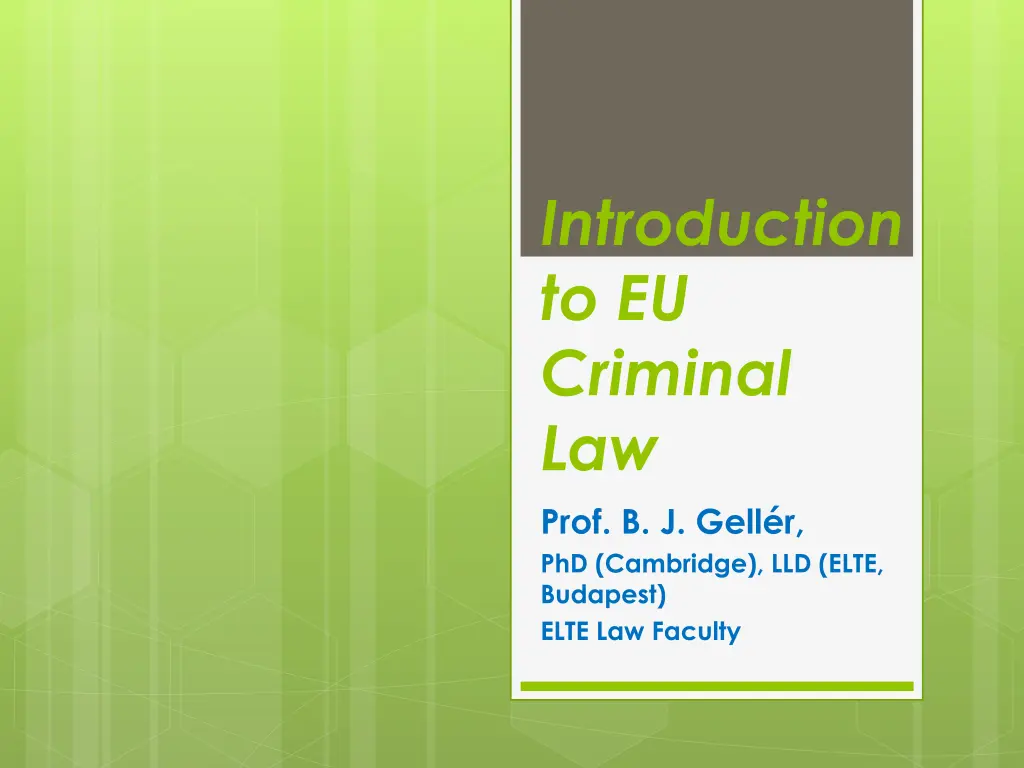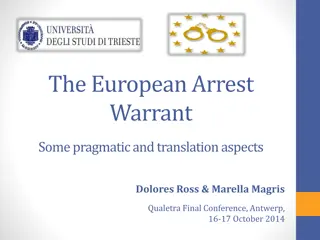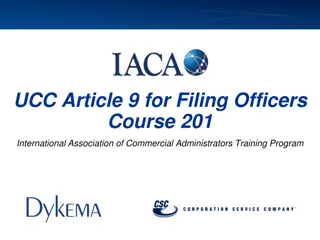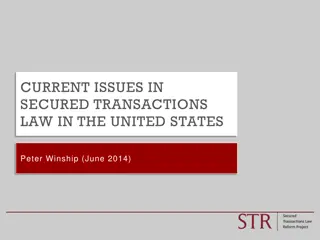
Development and Evolution of EU Criminal Law: A Historical Overview
Explore the historical context of EU criminal law, from the ideas of co-operation in criminal matters in the 1970s to the establishment of the TREVI Group in 1976 to counter terrorism. Learn about key events such as the Munich Olympic massacre and the formation of working groups within the TREVI framework, paving the way for mutual trust and recognition in today's EU criminal law landscape.
Download Presentation

Please find below an Image/Link to download the presentation.
The content on the website is provided AS IS for your information and personal use only. It may not be sold, licensed, or shared on other websites without obtaining consent from the author. If you encounter any issues during the download, it is possible that the publisher has removed the file from their server.
You are allowed to download the files provided on this website for personal or commercial use, subject to the condition that they are used lawfully. All files are the property of their respective owners.
The content on the website is provided AS IS for your information and personal use only. It may not be sold, licensed, or shared on other websites without obtaining consent from the author.
E N D
Presentation Transcript
Introduction to EU Criminal Law Prof. B. J. Gell r, PhD (Cambridge), LLD (ELTE, Budapest) ELTE Law Faculty
Contents I. Where to place EU criminal law? A short history II. Mutual trust and mutual recognition III. The EAW III.1. Difference between classical extradition and surrender (EAW) III.2. How does the EAW work? IV. Ne bis in idem V. EAW Article 1 (3) VI. Conclusion
I. Where to place EU criminal law? A short history 1970 s Idea of developing simpler forms of co- operation in criminal matters as existing under the Council of Europe treaties E.g. European Convention on Extradition (1957) European Convention on the Transfer of Proceedings in Criminal Matters (1972) European Convention on the International Validity of Criminal Judgments (1970)
56 September 1972 During the 1972 Summer Olympics in Munich (West Germany) the Palestinian militant organization Black September infiltrated the Olympic Village, killed two members of the Israeli Olympic team, and took nine others hostage, who were later killed during a failed rescue attempt.
TREVI GROUP The Trevi group was set up in 1976 by the 12 EC states to counter terrorism and to coordinate policing in the EC. The group's work was based on intergovernmental cooperation between the 12 states, a process which excluded the main EC institutions - the European Commission and the European Parliament. The creation of the Trevi group was preceded by a number of intergovernmental meetings on terrorism in 1971 and 1972. At a Council of Ministers meeting in Rome in December 1975 the Minsters agreed, to set up a special working group to combat terrorism in the EC. This proposal was formalised in Luxembourg on 29 June 1976 at a meeting in EC Interior Ministers. The decision meant that, in future, Ministers were accompanied by senior police and security service officials at these meetings. Five working groups were set up in 1976
Working group 1 (known as Trevi 1): responsible for measures to combat terrorism. Working group 2 (Trevi 2): scientific and technical knowledge and police training; the work of this group later expanded to embrace public order and football hooliganism. Working group 3 (Trevi 3): set up to deal with security procedures for civilian air travel; this work was later taken over by Trevi 1. Working group 4 (Trevi 4): safety and security at nuclear installations and transport. Working group 5 (Trevi 5): contingency measures to deal with emergencies (disasters, fire prevention and fire fighting). Of the original five working parties only two were active - Trevi 1 and Trevi 2.
TREVI intergovernmental network of national officials from ministries of justice and the interior outside the European Community framework created during the European Council Summit in Rome, 1 2 December 1975. Ceased to exist when it was integrated in the Justice and Home Affairs (JHA) pillar of the European Union (EU) (Treaty of Maastricht, 1993)
Creation: terrorist acts (hostage taking and consequent massacre during the 1972 Olympic Games in Munich), while TREVI initially intended to coordinate effective counter-terrorism responses among European governments Evolved into cross-border policing between the members of the European Community.
The first TREVI meeting at the level of senior officials was held in Rome (famous Trevi Fountain) chaired by a Dutchman Fonteijn (which translates into English as fountain) In some French textbooks it is sometimes noted that TREVI stands for Terrorisme, Radicalisme, Extr misme et Violence Internationale.
Schengen Schengen Agreement signed on 14 June 1985 by five of the then ten EU member states (Fr. G., Benelux States) The Schengen Area was established outside of the then European Community, when consensus could not be reached among all of its member states on the abolition of border controls. In 1990, the Agreement was supplemented by the Schengen Convention which proposed the abolition of internal border controls and a common visa policy.
The Agreements and the rules adopted under them were entirely separate from the EU structures, and led to the creation of the Schengen Area on 26 March 1995. The Agreement and related conventions were incorporated into the mainstream of European Union law by the Amsterdam Treaty in 1997, which came into effect in 1999. The UK and Ireland could not accept abolishing border controls but were given a full opt-out from the agreement. The Scandinavian members required Norway and Iceland to be included, which was accepted, and so a consensus could be reached.
Development of EU law 1993-2009 Title VI of the Treaty on European Union (TEU, Maastricht) cooperation on justice and home affairs in the so-called third pillar (1993) 1. European Communities pillar: (supranational) economic, social and environmental policies. European Community (EC), the European Coal and Steel Community (ECSC, until its expiry in 2002), and the European Atomic Energy Community (EURATOM). 2.The Common Foreign and Security Policy (CFSP) pillar: (intergovernmental cooperation) foreign policy and military matters 3. Justice and Home Affairs (JHA)).co- operation in the fight against crime. (intergovernmental cooperation)
Treaty of Amsterdam (1997, 1999) extended the provisions of the TEU, Title VI, Police and Judicial Co-operation in Criminal Matters (PJCC):(intergovernmental cooperation) common actions and framework decisions: acting unanimously on the initiative of any Member State or of the Commission, the Council may: (a) adopt common positions defining the approach of the Union to a particular matter; (b) adopt framework decisions for the purpose of approximation of the laws and regulations of the Member States. Framework decisions shall be binding upon the Member States as to the result to be achieved but shall leave to the national authorities the choice of form and methods. They shall not entail direct effect;
Very importantly the Schengen acquis became part of the legal framework of the European Union through the Protocol attached to the Treaty of Amsterdam in 1999.
Council Framework Decision 2002/584/JHA The most important EU law document governing the EAW is the Council Framework Decision of 13 June 2002 on the European arrest warrant and the surrender procedures between Member States (2002/584/JHA). The first concrete measure in the field of criminal law implementing the principle of mutual recognition of judicial decisions. It came into force on 1 January 2004 and is founded on the principle of direct contacts between the judicial authorities. (Proposal from the Commission: 27.11.2001., opinion of the European Parliament: 9.1.2002. , adoption by the Council: 13.6.2002.)
Legal basis WAS TEU Legal basis: Treaty on European Union, Article 31(a) and (b) and Article 34(2)(b) Article 31 (1) Common action on judicial cooperation in criminal matters shall include: (a) facilitating and accelerating cooperation between competent ministries and judicial or equivalent authorities of the Member States, including, where appropriate, cooperation through Eurojust, in relation to proceedings and the enforcement of decisions; Article 34 (2) The Council shall take measures and promote cooperation, using the appropriate form and procedures as set out in this title, contributing to the pursuit of the objectives of the Union. To that end, acting unanimously on the initiative of any Member State or of the Commission, the Council may: (b) adopt framework decisions for the purpose of approximation of the laws and regulations of the Member States. Framework decisions shall be binding upon the Member States as to the result to be achieved but shall leave to the national authorities the choice of form and methods. They shall not entail direct effect;
29th May 2000 Convention in accordance with Article 34 of the Treaty on European Union the Convention on Mutual Assistance in Criminal Matters between the Member States of the European Union (2000/C 197/01) (intergovernmental cooperation) Council Framework Decision 2008/909/JHA of 27 November 2008 on the application of the principle of mutual recognition to judgments in criminal matters imposing custodial sentences or measures involving deprivation of liberty for the purpose of their enforcement in the European Union
Lisbon Treaty (2007, 2009) The Lisbon Treaty eliminated the third pillar, regrouped these provisions in the Treaty on the Functioning of the European Union (TFEU) under Title V: "AREA OF FREEDOM, SECURITY AND JUSTICE" Legal acts adopted prior to the entry into force of the Lisbon Treaty in the field of criminal cooperation are in force.
TITLE V AREA OF FREEDOM, SECURITY AND JUSTICE Chapter 1 General provisions Chapter 2 Policies on border checks, asylum and immigration Chapter 3 Judicial cooperation in civil matters Chapter 4 Judicial cooperation in criminal matters Chapter 5 Police cooperation
TFEU CHAPTER 4 JUDICIAL COOPERATION IN CRIMINAL MATTERS Article 82 (ex Article 31 TEU) 1. Judicial cooperation in criminal matters in the Union shall be based on the principle of mutual recognition of judgments and judicial decisions and shall include the approximation of the laws and regulations of the Member States in the areas referred to in paragraph 2 and in Article 83.The European Parliament and the, Council acting in accordance with the ordinary legislative procedure, shall adopt measures to: (a) lay down rules and procedures for ensuring recognition throughout the Union of all forms of judgments and judicial decisions; (b) prevent and settle conflicts of jurisdiction between Member States; (c) support the training of the judiciary and judicial staff; (d) facilitate cooperation between judicial or equivalent authorities of the Member States in relation to proceedings in criminal matters and the enforcement of decisions.
2. To the extent necessary to facilitate mutual recognition of judgments and judicial decisions and police and judicial cooperation in criminal matters having a cross-border dimension, the European Parliament and the Council may, by means of directives adopted in accordance with the ordinary legislative procedure, establish minimum rules. Such rules shall take into account the differences between the legal traditions and systems of the Member States. They shall concern: (a) mutual admissibility of evidence between Member States; (b) the rights of individuals in criminal procedure; (c) the rights of victims of crime; (d) any other specific aspects of criminal procedure which the Council has identified in advance by a decision; for the adoption of such a decision, the Council shall act unanimously after obtaining the consent of the European Parliament. Adoption of the minimum rules referred to in this paragraph shall not prevent Member States from maintaining or introducing a higher level of protection for individuals.
Article 83 (ex Article 31 TEU) 1. The European Parliament and the Council may, by means of directives adopted in accordance with the ordinary legislative procedure, establish minimum rules concerning the definition of criminal offences and sanctions in the areas of particularly serious crime with a cross-border dimension resulting from the nature or impact of such offences or from a special need to combat them on a common basis. These areas of crime are the following: terrorism, trafficking in human beings and sexual exploitation of women and children, illicit drug trafficking, illicit arms trafficking, money laundering, corruption, counterfeiting of means of payment, computer crime and organised crime. On the basis of developments in crime, the may adopt a decision identifying other areas of crime that meet the criteria specified in this paragraph. It shall act unanimously after obtaining the consent of the European Parliament.
The Treaty on European Union (2007) is one of the primary Treaties of the European Union, alongside the Treaty on the Functioning of the European Union (TFEU). The TEU forms the basis of EU law, by setting out general principles of the EU's purpose, the governance of its central institutions (such as the Commission, Parliament, and Council) etc. While the current version of the TEU entered into force in 2009, following the Treaty of Lisbon (2007), the older form of the same document was implemented by the Maastricht Treaty (1993).
The Treaty on the Functioning of the European Union (TFEU) is one of two (three) treaties forming the constitutional basis of the European Union (EU), the other being the Treaty on European Union (TEU). It was previously known as the Treaty Establishing the European Community (TEC) It was signed on 25 March 1957 by Belgium, France, Italy, Luxembourg, the Netherlands and West Germany and came into force on 1 January 1958. It remains one of the two most important treaties in the modern-day European Union (EU). Its name has been amended twice since 1957. The Maastricht Treaty of 1993 removed the word "economic" from the Treaty of Rome's official title and, in 2009, the Treaty of Lisbon renamed it the "Treaty on the Functioning of the European Union".
EU Charter of Fundamental Rights The Charter was initially solemnly proclaimed at the Nice European Council on 7 December 2000. At that time, it did not have any binding legal effect. On 1 December 2009, with the entry into force of the Lisbon Treaty, the Charter became legally binding on the EU institutions and on national governments, just like the Treaties themselves. The Charter contains rights and freedoms under six titles: Dignity, Freedoms, Equality, Solidarity, Citizens' Rights, and Justice. The Charter is consistent with the European Convention on Human Rights adopted in the framework of the Council of Europe: when the Charter contains rights that stem from this Convention, their meaning and scope are the same.
EU framework decision on criminal law some key framework decisions: 1. Framework Decision 2002/475/JHA (on combating terrorism): Establishes a common definition of terrorism and outlines measures for prevention, prosecution, and cooperation among member states. 2. Framework Decision 2003/577/JHA (on the execution in the European Union of orders freezing property or evidence): Provides a legal basis for mutual recognition of freezing orders across EU member states. 3. Framework Decision 2008/977/JHA (on the protection of personal data processed in the framework of police and judicial cooperation in criminal matters): Aims to protect personal data while allowing for necessary data exchanges between law enforcement agencies. 4. Framework Decision 2009/315/JHA (on the establishment of a European criminal record): Facilitates the exchange of criminal record information among EU member states to enhance criminal justice cooperation. 5. Framework Decision 2009/948/JHA (on the prevention and settlement of conflicts of jurisdiction in criminal proceedings): Aims to prevent conflicts of jurisdiction and to ensure that criminal proceedings are effectively coordinated among member states. 6. Framework Decision 2002/629/JHA (on combating trafficking in human beings): Provides a common framework for combating human trafficking and ensures victim protection.
EU directives in the field of criminal law some key directives: 1. Directive 2011/93/EU (on combating the sexual abuse and sexual exploitation of children): Focuses on prevention, prosecution, and protection of children from sexual crimes. 2. Directive 2012/29/EU (establishing minimum standards on the rights, support, and protection of victims of crime): Ensures that victims are treated with respect and provided with support throughout the judicial process. 3. Directive 2013/48/EU (on the right of access to a lawyer): Guarantees the right to legal counsel for individuals suspected of or accused of a crime. 4. Directive 2014/41/EU (on the European Investigation Order): Facilitates cross-border cooperation in criminal investigations by allowing evidence to be collected across EU member states. 5. Directive 2016/343/EU (on the presumption of innocence and the right to be present at the trial): Establishes rights related to the presumption of innocence and ensures that defendants can attend their trials. 6. Directive 2016/1919/EU (on access to legal aid): Aims to ensure effective access to legal aid for those who cannot afford it. 7. Directive 2017/1371/EU (on the fight against fraud to the Union s financial interests): Addresses crimes that harm the financial interests of the EU.
EU regulations on criminal law some key regulations: 1. Regulation (EU) 2016/794 (establishing the European Union Agency for Law Enforcement Cooperation - Europol): This regulation outlines the framework for Europol's operations, facilitating information sharing and operational cooperation among member states. 2. Regulation (EU) 2018/1725 (on the protection of personal data by EU institutions): While primarily focused on data protection, this regulation impacts criminal law by establishing how personal data is handled by EU agencies involved in criminal matters. 3. Regulation (EU) 2019/817 (on the European Criminal Records Information System - ECRIS): This regulation enhances the functioning of ECRIS for sharing criminal record information across member states, improving cooperation in criminal justice. 4. Regulation (EU) 2016/1624 (on the European Border and Coast Guard): Although primarily concerned with border security, it includes provisions related to combating cross- border crime.
DIRECTIVE (EU) 2024/1226 OF THE EUROPEAN PARLIAMENT AND OF THE COUNCIL of 24April 2024 on the definition of criminal offences and penalties for the violation of Union restrictive measures and amending Directive (EU) 2018/1673 Whereas: (1) In order to ensure the effective application of Union restrictive measures, the integrity of the internal market within the Union, and to achieve a high level of security within the area of freedom, security and justice, it is necessary to establish minimum rules concerning the definition of criminal offences and penalties for the violation of those Union restrictive measures.
Restrictive measures (sanctions) In the context of the European Union s common foreign and security policy (CFSP), Article 29 of the TEU allows the Council of the European Union to adopt a decision to impose restrictive measures also often referred to as sanctions against non-EU countries, non-state entities or individuals. These measures are imposed to bring about a change in policy or activity by the target party. Restrictive measures may include: - prohibitions on the export of arms and related equipment, - visa/travel ban, - economic measures such as restrictions on imports and exports - freezing of funds and economic resources owned by targeted individuals or entities. Directive - EU - 2024/1226 - EN - EUR-Lex
Directive (EU) 2024/1203 of the European Parliament and of the Council of 11 April 2024 on the protection of the environment through criminal law and replacing Directives 2008/99/EC and 2009/123/EC Article 1 Subject matter This Directive establishes minimum rules with regard to the definition of criminal offences and penalties in order to protect the environment more effectively, as well as with regard to measures to prevent and combat environmental crime and to effectively enforce Union environmental law. Directive - EU - 2024/1203 - EN - EUR-Lex
II. Mutual trust and mutual recognition - EAW - OPINION 2/13 OF THE COURT (18 December 2014) Para. 168 - C-187/01 and C-385/01 G z tok and Br gge (2003), paragraph 38 - C-469/03 Miraglia (2005), paragraph 32). - C-436/04 Van Esbroeck (2006)
EAW was the first concrete measure putting the principle of mutual recognition - that is, one Member State must recognise the decisions of another MS s judicial authorities - into practice. Case C-436/04 Van Esbroeck [2006] ECLI:EU:C:2006:165. referring to joined cases C-187/01 and C-385/01 H seyin G z tok and Klaus Br gge [2003] EU:C:2003:87, para 33. there is a necessary implication in the ne bis in idem principle that the Contracting States have mutual trust in their criminal justice systems and that each of them recognises the criminal law in force in the other Contracting States even when the outcome would be different if its own national law were applied. (Connection to ne bis in idem!!)
Case C-436/04 Van Esbroeck 30. There is a necessary implication in the ne bis in idem principle, enshrined in that Article, that the Contracting States have mutual trust in their criminal justice systems and that each of them recognises the criminal law in force in the other Contracting States even when the outcome would be different if its own national law were applied ([Case C-385/01] G z tok and Br gge [[2003] ECR I-1345], paragraph 33). 31. It follows that the possibility of divergent legal classifications of the same acts in two different Contracting States is no obstacle to the application of Article 54 of the CISA. 32. For the same reasons, the criterion of the identity of the protected legal interest cannot be applicable since that criterion is likely to vary from one Contracting State to another. 33. The above findings are further reinforced by the objective of Article 54 of the CISA, which is to ensure that no one is prosecuted for the same acts in several Contracting States on account of his having exercised his right to freedom of movement (G z tok and Br gge, paragraph 38, and Case C- 469/03 Miraglia [2005] ECR I-2009, paragraph 32).
OPINION 2/13 OF THE COURT (18 December 2014) Para. 168 This legal structure is based on the fundamental premiss that each Member State shares with all the other Member States, and recognises that they share with it, a set of common values on which the EU is founded, as stated in Article 2 TEU. That premiss implies and justifies the existence of mutual trust between the Member States that those values will be recognised and, therefore, that the law of the EU that implements them will be respected.
To safeguard - set of common values on which the EU is founded, as stated in Article 2 TEU - Freedom of movement of TOOLS: - EAW - Ne bis in idem (also a principle for refusing a EAW)
III. The EAW III.1. The difference between classical extradition and surrender (EAW) International Co-operation in Criminal Matters a) recognition of foreign judgments b) extradition c) transfer of criminal proceedings d) transfer of prisoners e) executing proceedings in another State (deposing witnesses, seizing evidence etc.)
Principles of Extradition Double Criminality - concrete - abstract extradition is available is only when the act is an offence in both States
Exemptions No extradition of citizens! Section 14 of the Extradition Act 1965 prevents the extradition of an Irish national unless the relevant extradition treaty or arrangement provides otherwise. For example, treaties with the United States and with Australia apply to Irish citizens or nationals. Article 3 Political offences Article 4 Military offences Article 5 Fiscal offences Article 6 Extradition of nationals Article 7 Place of commission Article 10 Lapse of time Article 11 Capital punishment Procedure Public order decisions
III.2. How does the EAW work?
The EAW is a judicial decision enforceable in the Union that is issued by a Member State and executed in another Member State on the basis of the principle of mutual recognition. The EAW replaced the traditional system of extradition with a simpler and quicker mechanism for the surrender of requested persons for the purposes of conducting a criminal prosecution or executing a custodial sentence or detention order. An EAW may be issued for the purposes of: (a) a criminal prosecution in relation to acts punishable under domestic law by a custodial sentence or detention order for a maximum period of at least investigation, examining and trial stages, until the conviction is final); 12 months (during the (b) the execution of a sentence or detention order of at least 4 months.
COMMISSION STAFF WORKING DOCUMENT Statistics on the practical operation of the European arrest warrant 2022 (p.6)
Statistics on the EAW 32810655-fe94-44c2-9099-2813c42c9adb_en
Art 2(2): The following offences shall give rise to surrender - participation in a criminal organisation, - terrorism, - trafficking in human beings, - sexual exploitation of children and child pornography, - illicit trafficking in narcotic drugs and psychotropic substances, - illicit trafficking in weapons, munitions and explosives, - corruption, - fraud, including that affecting the financial interests of the European Communities within the meaning of the Convention of 26 July 1995 on the protection of the European Communities' financial interests, - laundering of the proceeds of crime, - counterfeiting currency, including of the euro, - computer-related crime,
- environmental crime, including illicit trafficking in endangered animal species and in endangered plant species and varieties, - facilitation of unauthorised entry and residence, - murder, grievous bodily injury, - illicit trade in human organs and tissue, - kidnapping, illegal restraint and hostage-taking, - racism and xenophobia, - organised or armed robbery, - illicit trafficking in cultural goods, including antiques and works of art, - swindling, - racketeering and extortion, - rape, - arson, - crimes within the jurisdiction of the International Criminal Court, - unlawful seizure of aircraft/ships, - sabotage.
Before issuing the EAW, the competent judicial authority should determine whether one or more of the offences belong to one of the 32 categories in respect of which the verification of double criminality does not apply. The list of offences is in Article 2(2) of the Framework Decision on EAW and also on the EAW form, where offences belonging to the list should be ticked . It is the issuing Member State s law which is decisive. This was confirmed in the judgment in Case C-303/05 Advocaten voor de Wereld (2007) where the Court of Justice held that Article 2(2) of the Framework Decision on EAW is not incompatible with the principle of the legality of criminal offences and penalties and does not breach the principle of equality and non-discrimination. The executing judicial authority can only verify double criminality in respect of offences that are not in the list of 32 offences






















